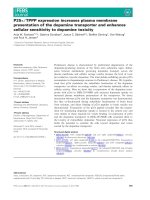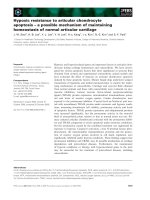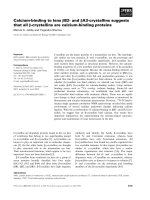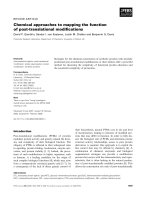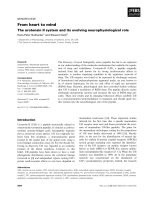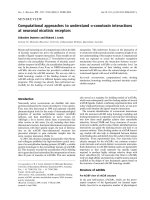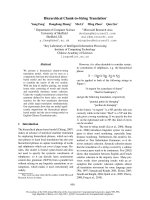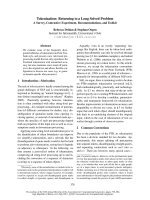Báo cáo khoa học: " Dose reduction to normal tissues as compared to the gross tumor by using intensity modulated radiotherapy in thoracic malignancies" doc
Bạn đang xem bản rút gọn của tài liệu. Xem và tải ngay bản đầy đủ của tài liệu tại đây (220.57 KB, 6 trang )
BioMed Central
Page 1 of 6
(page number not for citation purposes)
Radiation Oncology
Open Access
Methodology
Dose reduction to normal tissues as compared to the gross tumor
by using intensity modulated radiotherapy in thoracic malignancies
Tejinder Kataria*
1
, Sheh Rawat
1
, SN Sinha
2
, C Garg
1
, NK Bhalla
1
and
PS Negi
2
Address:
1
Department of Radiation Oncology, Rajiv Gandhi Cancer Institute and Research Center, N. Delhi, India and
2
Department of Medical
Physics, Rajiv Gandhi Cancer Institute and Research Center, N. Delhi, India
Email: Tejinder Kataria* - ; Sheh Rawat - ; SN Sinha - ;
C Garg - ; NK Bhalla - ; PS Negi -
* Corresponding author
Abstract
Background and purpose: Intensity modulated radiotherapy (IMRT) is a powerful tool, which
might go a long way in reducing radiation doses to critical structures and thereby reduce long term
morbidities.
The purpose of this paper is to evaluate the impact of IMRT in reducing the dose to the critical
normal tissues while maintaining the desired dose to the volume of interest for thoracic
malignancies.
Materials and methods: During the period January 2002 to March 2004, 12 patients of various
sites of malignancies in the thoracic region were treated using physical intensity modulator based
IMRT. Plans of these patients treated with IMRT were analyzed using dose volume histograms.
Results: An average dose reduction of the mean values by 73% to the heart, 69% to the right lung
and 74% to the left lung, with respect to the GTV could be achieved with IMRT.
The 2 year disease free survival was 59% and 2 year overall survival was 59%. The average number
of IMRT fields used was 6.
Conclusion: IMRT with inverse planning enabled us to achieve desired dose distribution, due to
its ability to provide sharp dose gradients at the junction of tumor and the adjacent critical organs.
Background
Curative doses of radiation in many instances may lead to
a good disease control but cause radiation induced
chronic morbidities such as interstitial capillary injury of
the myocardium leading to an increased incidence of cor-
onary artery disease, cardiomyopathy and pulmonary
interstitial fibrosis. These toxicities are dose related and
different structures have varying tolerance to radiation.
The availability of data on tissue tolerances makes it
imperative to respect the tolerance of critical structures
such as the heart, lungs, esophagus etc. and reduce associ-
ated morbidities while improving the quality of life.
In most clinical situations, the radiation oncologist is
compromised in prescription to treat to tolerance doses of
normal tissues rather than to specific tumoricidal dose.
Published: 29 August 2006
Radiation Oncology 2006, 1:31 doi:10.1186/1748-717X-1-31
Received: 11 May 2006
Accepted: 29 August 2006
This article is available from: />© 2006 Kataria et al; licensee BioMed Central Ltd.
This is an Open Access article distributed under the terms of the Creative Commons Attribution License ( />),
which permits unrestricted use, distribution, and reproduction in any medium, provided the original work is properly cited.
Radiation Oncology 2006, 1:31 />Page 2 of 6
(page number not for citation purposes)
IMRT has the potential to increase this therapeutic ratio.
The use of IMRT as against conventional radiation allows
one to sculpt the dose around a complex shaped target,
and has the potential to deliver a higher biologically effec-
tive dose to the target. A number of studies have demon-
strated the superiority of the physical dose distribution of
IMRT compared to other modalities with application in
brain tumors, head and neck cancers and prostate cancer
treatments [1,2]. As compared to conventional beams, the
complexity of IMRT dose patterns makes the verification
of the match between planned and delivered doses con-
siderably more difficult. The accuracy of delivered doses is
a critical issue for ongoing quality assurance in an IMRT
program. Several different techniques have been
described and used for clinical implementation of IMRT.
These include the "step and shoot" auto sequence multi-
leaf collimator (MLC), dynamic MLC and the physical
intensity modulation. The "step and shoot" auto sequence
MLC technique delivers an intensity modulated photon
field by irradiating a sequence of static MLC ports. The
dynamic MLC technique delivers an intensity modulated
photon field by moving the collimator leaves during irra-
diation [3]. Physical intensity modulators are being used
to deliver IMRT since the advent of inverse planning soft-
ware [4]. Schulz [5] and Chang et al [6] have shown in a
comparative study between different techniques of IMRT
that the MLC technology requires considerably longer
time (100%–400%) to deliver the treatment as compared
to PIM based IMRT. They have also found a better target
volume dose uniformity with PIMs. Sherouse has elabo-
rated that the solid filters are the gold standard and MLC
can be an acceptable compromise [7]. He has described
solid milled physical modulators as the technology of
choice for implementing fluence modulation for IMRT.
PIMs are more reliable as the photons are absorbed the
same way every time by the PIM, whereas the initial vali-
dation measurement in MLC may vary a week later [7].
Hence a day-to-day quality assurance is required to main-
tain an MLC based IMRT programme. The resolution of
PIM is greater in one of the two dimensions because of the
size of the MLC leaves, which is typically either 1 cm or 5
mm. The problem of time invariance arises with moving
tissues. In dynamic MLC, if the target moves left while the
right segment is treated and weaves right while the left seg-
ment is treated, there is a potential of 100% error [7].
We present our initial experience with the designing,
implementation and dosimetric aspects of IMRT plans of
12 patients.
Materials and methods
It is a heterogeneous population with post chemotherapy
Hodgkin's and non Hodgkin's lymphoma, bronchogenic
carcinoma, post operative case of soft tissue sarcoma and
tracheo bronchial recurrence in a treated case of carci-
noma esophagus.
Planning-A thermoplastic cast was made in the treatment
position on the simulator using laser beam alignment and
fiducial markers were placed on the thermoplastic cast. A
planning CT scan with contrast at cross sections of 3 mm
was performed after aligning the external fiducial markers
to lasers. The CT images were then transferred to the treat-
ment-planning computer through direct cable network.
Contouring of the tumor and critical normal structures
was done by the radiation oncologist with the assistance
of a radiologist on every CT slice. Prescription of dose to
the target and defining dose constraints for the critical
normal structure such as the lungs, cord, heart etc. was
done keeping in mind the partial tolerances from the pub-
lished literature [8]. (Table 2) This patient data facilitated
virtual reconstruction of patient anatomy with tumor and
organs at risk.
A photon fluence pattern of each individual beam was
generated that met the defined dose constraints on the 3
dimensional treatment planning system (3 D TPS – Plato,
Nucletron International) with inverse planning and opti-
mization software. The fluence patterns were used to
design and cut special Necupur templates on computer-
ized numerically controlled 3 D milling machine (Autimo
system, Hek Medizintechnik). These templates were sub-
sequently used to mould physical intensity modulators
(PIMs) of Cerro bend [4]. Re simulation was done for ver-
ification of isocenter placement as per optimized plan
with the help of previously placed fiducial markers. Pho-
ton fluence pattern from film dosimetry (Vidar scanner)
as well as by portal imaging were matched with that of
optimized fluence maps from treatment planning system
for each beam.
Percentage PTV receiving 100% prescribed dose (V100),
percentage PTV receiving less than 93% dose (V93) and
percentage PTV receiving more than 110% of prescribed
dose (V110) were evaluated as per Collaborative Working
Group (CWG) recommendations [9]. The homogeneity
index (H.I.) was calculated by evaluating the percentage
variation between 95% and 10% volume of the PTV using
the following formula H.I. = D
10
/D
95
where D
10
is the
dose received by 10% PTV, and D
95
is the dose received by
95% of the PTV [10,11].
Statistical analysis was done using SPSS software version
10. Disease free survival (DFS) and overall survival (OS)
were calculated by Kaplan Meier method. The DFS was
calculated from the date of completion of the planned
treatment and OS was calculated from the date of com-
mencement of treatment. For calculating DFS, "disease
Radiation Oncology 2006, 1:31 />Page 3 of 6
(page number not for citation purposes)
recurrence", "residual disease" and "lost to follow up with
disease" were taken as events while for calculating the OS,
"cause specific death", "lost to follow up with disease"
and "alive with disease" were considered as events.
Results
The median age was 50 (35–75) years. The median follow
up was 15 months. Seven out of twelve patients achieved
a complete response (C.R.), two had partial response
(P.R.), one had progressive disease, one died of cause
other than cancer and one patient was lost to follow up.
Of the 2 patients who had P.R., one patient (case 12)
underwent salvage chemotherapy and again had only a
partial response to second line chemotherapy (3 cycles)
and third line chemotherapy (1 Cycle) and was subse-
quently lost to follow up with disease.
The average number of IMRT fields was 6 (range 5–8).
For PTV, V100 was 76.4% (65%–100%), V93 was 2.9%
(0%–10%) and V110 was 9.9% (0%–46%). For GTV,
V100 was 76.4% (65%–100%), V93 was 3.08% (0%–
10%) and V110 was 7.4% (0%–46%). The homogeneity
index (H.I.) calculated by evaluating the percentage varia-
tion between 95% and 10% volume of the PTV was 1.1
(1–1.2) and 95% and 10%volume of the GTV was 1.1%
(1–1.2) (Table 3). It is important to note that the maxi-
mum dose described by the International Commission on
Radiation Units and Measurements Report 50 is the
region that is encompassed by a 1.5 cm
3
[12].
With IMRT plans we were able to achieve an average
reduction in mean doses by 73% to the entire heart, 69%
to two third of the heart, 49% to one third and 69% to the
entire right lung, 70% to two third and 54% to one third
right lung, 74% to the entire left lung, 61% to two third
and 47% to one third left lung with respect to the GTV.
(Table 4).
The mean dose to the whole heart was 20.4 Gy (2 Gy – 35
Gy) and to 1/3
rd
heart was 21.6 Gy (2 Gy – 39 Gy), 2/3
rd
of the right and left lungs received a mean dose of 13 Gy
(1 Gy – 28 Gy) and 17 Gy (2 Gy – 28 Gy) respectively
while the entire right and left lungs received a mean dose
of 17.7 Gy (3 Gy – 31 Gy) and 22 Gy (12 Gy – 32 Gy)
respectively (Table 4).
Acute and late toxicities
One patient (case 12) had evidence of asymptomatic
patchy bilateral pulmonary opacities as seen on the chest
x-ray at 2 months following radiation. She developed
symptomatic bilateral pulmonary infiltrates and minimal
pleural effusion with fever and breathlessness at rest at 3
months post radiation. The patient was managed conserv-
atively with a short course of antibiotics and tapering ster-
oids and the symptoms subsided by sixth month. Entire
right and left lungs received a mean dose of 24 Gy each, 2/
3
rd
right and left lungs received 13 Gy and 20 Gy each and
1/3
rd
right and left lungs received a dose of 25 and 32 Gy
each.
2 year DFS was 59% with a mean of 24.17 months [95%
C.I. 13.54, 34.81] and 2 year OS was 59% with a mean of
45.7 months [95% C.I. 26.55, 64.85].
Discussion
Gross tumor volume (GTV) is taken as the gross extent of
the tumor as shown by imaging studies coupled with the
findings on physical examination in lymphoma cases and
Table 2: Dose constraints prescribed for organ at risks.
Organ at risk organ 3/3 Organ 2/3 organ 1/3
Heart 40 Gy 45 Gy 60 Gy
Lung 17.5 Gy 30 Gy 45 Gy
Spinal Cord: Maximum point dose – 45 Gy
Table 1: Patient characteristics.
Case No. Age Sex Primary site
1 54 M Hodgkin's lymphoma II A-mediastinum
2 64 M Soft Tissue Sarcoma (PO)*-right chest wall
3 75 M Non Small cell lung cancer T2N2M0-right upper lobe
4 69 M Non Small cell lung cancer Stage III-left upper lobe with chest wall infiltration
5 37 F Soft Tissue Sarcoma (PO)-dome of diaphragm
6 64 M Non Small cell lung cancer T2N2M0-right upper lobe
7 38 M Esophagus with Tracheobronchial recurrence
8 75 M Non Small cell lung cancer Stage III-left upper lobe
9 45 M Hodgkin's lymphoma III B-mediastinum
10 44 F Non Hodgkin's lymphoma II A-mediastinum
11 42 M Non Hodgkin's lymphoma III-mediastinum
12 35 F Hodgkin's lymphoma II B-mediastinum
* Post operative
Radiation Oncology 2006, 1:31 />Page 4 of 6
(page number not for citation purposes)
clinical target volume (CTV) was defined at 10 mm from
the GTV. In post operative cases, the CTV for every case
was individualized according to the drainage areas, infor-
mation regarding the tumor bed as per surgical notes and
knowledge regarding organ motion. The cases of lung car-
cinoma that were treated with IMRT were inoperable. The
concept of gated IMRT is still under evolution and not
available at our center. The excursion of the lungs was
seen during simulation and due consideration was given
to organ motion while contouring the target volumes. The
uniformity of margin was not kept if some highly sensitive
structure was in the proximity. PTV was placed at 3–5 mm
outside the CTV and the beam edge to PTV was placed at
3–4 mm by the medical physicist.
There is paucity of data regarding the practice of IMRT in
thoracic malignancies in literature using physical intensity
modulators. We have presented the initial observations
and results using PIMs and this is the only study highlight-
ing daily reproducibility, accuracy and outcomes using
this technique so far available in literature [13]. The only
technical advantage of MLC in present time seems to be
that it does not involve manufacturing of a physical mod-
ulator which is time consuming and that the technologist
does not have to go in the treatment room again and again
to change the PIM.
Radiation injury to the heart is most often manifested as
pericarditis, although other complications such as chronic
pericardial effusion or myocardial infarction may occur.
Table 3: Evaluation indices.
Case No. V*100 V*93 V*110 Homogeneity Index No of IMRT fields
PTV† GTV‡ PTV GTV PTV GTV PTV GTV
1909000201.21.1 5
29090023001.21.1 6
375750105511 7
4707082001.11.1 8
5666652111.11.1 6
6 100 100 0 0 46 46 1.2 1.1 6
7666600551.21 6
8666641201.11.1 6
96666101015151.21.2 7
10 97 97 6 0 10 0 1.1 1.1 6
11 66 66 0 10 3 14 1.2 1.2 6
12 65 65 2 0 0 3 1 1 6
Average 76.4 76.4 2.9 3.08 9.9 7.41 1.1 1.1 6
*V 100, V 93, V 110 Percentage volume receiving 100% dose, less than 93% dose and more than 110% dose.
† Planning target volume, ‡ Gross target volume,
Table 4: Normalized total dose to 2 Gray for various structures.
Case
no.
GTV* PTV† Right lung Left lung Heart Liver
Thorax Whole
organ
2/3 rd 1/3 rd Whole
organ
2/3 rd 1/3 rd Whole
organ
2/3 rd 1/3 rd Whole
organ
2/3 rd 1/3 rd
1 4343212832192731341616 - - -
2 5753332836232222302532 - - -
3 5959322339233029292334 - - -
4 5959131517132838241528131313
5 5048111113111219181220111217
6 6060403444332937353036252224
7 5347 111922191322
8 6260131624131436281435131313
9 -402 4232101815919- - -
10 45 40 10 13 25 10 20 32 19 17 21 10 10 11
11 -271 3 9 1101510514- - -
12 40 40 6 12 14 6 6 12 6 12 36 4 5 5
GTV* Gross tumor volume; PTV† Planning target volume.
Radiation Oncology 2006, 1:31 />Page 5 of 6
(page number not for citation purposes)
There is ample evidence in literature regarding radiation
injury from whole heart irradiation for patients with
Hodgkin's disease and partial volume radiation induced
heart complications from patients treated post operatively
for breast cancer [14]. Literature confirms to TD 5/5 of 40
Gy to whole organ or 60 Gy for 1/3
rd
organ.
In our series, the mean dose to full heart was 14.8 Gy (1
Gy – 35 Gy), two third heart was less than was 15.9 Gy (5
Gy – 30 Gy) and 1/3
rd
heart received 25.3 Gy (14 Gy – 36
Gy).
The two most important consequences of irradiation to
lungs are pneumonitis and pulmonary fibrosis. Pulmo-
nary fibrosis occurs in almost 100% of patients receiving
high doses of irradiation [15-17] but may not be of clini-
cal significance if the volume is small enough. This has
been reported in a diverse group of patients afflicted with
various diseases but mostly from patients with Hodgkin's
disease [18-23] and lung cancer [24]. The TD 5/5 for
whole lung is 17.50 Gy, 2/3
rd
lung is 30 Gy and 1/3
rd
lung
is 45 Gy [8].
In our series, 2/3
rd
of the right and left lungs received a
mean dose of 17 Gy (3 Gy – 34 Gy) and 19.4 Gy (10 Gy –
30 Gy) respectively while the entire right and left lungs
received a mean dose of 16.5 Gy (1 Gy – 40 Gy) and 13.8
Gy (1 Gy – 33 Gy) respectively (Table 4).
However, there are some areas of concern in planning and
delivery of IMRT. Although parameters such as organ
movements and daily patient set up variation are
accounted for to some extent in the concept of PTV, there
is no provision for the shrinkage of the gross tumor and
subsequent change in geometry over the course of radio-
therapy.
In view of the fact that IMRT introduces steep gradients
near the perimeter of both the target volume and normal
structures, IMRT can be "less forgiving" than conventional
radiation in regard to the effects resulting from such geo-
metric uncertainties.
Conclusion
A reduced volume of normal tissues receiving radiation
should hypothetically decrease the radiation morbidity,
permitting escalation of tumor dose, thereby yielding
higher rates of tumor control. In our series, it was possible
to achieve an average reduction in the mean dose by 73%
to the heart, 69% to the right lungs, 74% to the left lungs
and 66% to the cord with respect to the GTV. Only one
patient (case 10) developed symptomatic pulmonary
pneumopathy which was managed conservatively. It was
also possible to re-irradiate a thoracic esophageal recur-
rence with good clinical response in respiratory obstruc-
tion.
IMRT is a tool that has already proven its efficacy in head
and neck cancers. With the advent of image guided radio-
therapy, reduction in planning target volume is envisaged
in future. However, we were able to deliver tumoricidal
doses to the target in our heterogeneous group of patients
without exceeding the tolerance limits of critical target tis-
sues in the vicinity. This may not have been possible if
conventional radiation was planned for these patients.
IMRT will open up new vistas in cases of re irradiation
wherein critical structures have already received near tol-
erance doses of radiation.
References
1. Cardinale RM, Benedict SH, Wu Q, Zwicker RD, Gaballa HE, Mohan
R: A comparison of three stereo tactic techniques; ARCS vs.
noncoplanar fixed field vs. intensity modulation. Int J Radiat
Oncol Biol Phys 1998, 42:431-436.
Table 5: Patient Outcomes
Case No. Follow up (Months) Disease Status DFS* (months) OS† (months)
1 37 Complete Response 30 37
2 15 Complete Response 14 15
3 9 Died (other cause) 4 9
4 0 Status Unknown 0 0
5 6 Complete Response 4 6
6 10 Complete Response 5 10
7 19 Progressive Disease 0 19
8 6 Partial Response 4 6
9 38 Complete Response 30 38
10 27 Complete Response 22 27
11 59 Complete Response 26 59
12 7 Partial Response 7 7
* Disease free survival, † Overall survival
Publish with BioMed Central and every
scientist can read your work free of charge
"BioMed Central will be the most significant development for
disseminating the results of biomedical researc h in our lifetime."
Sir Paul Nurse, Cancer Research UK
Your research papers will be:
available free of charge to the entire biomedical community
peer reviewed and published immediately upon acceptance
cited in PubMed and archived on PubMed Central
yours — you keep the copyright
Submit your manuscript here:
/>BioMedcentral
Radiation Oncology 2006, 1:31 />Page 6 of 6
(page number not for citation purposes)
2. Verhey LJ: Comparison of three dimensional conformal radia-
tion therapy and Intensity modulated radiotherapy systems.
Semin Oncol 1999, 9:78-98.
3. Jiang SB, Ayyangar KM: On modulator design for photon beam
intensity modulated conformal therapy. Med Phys 1998,
25:668-675.
4. Negi PS: Intensity modulated radiotherapy (IMRT) with phys-
ical intensity modulators (PIMs) – a competing technology to
MLC based IMRT. J Med Phys (Synopses book) 2002, 27(3):85-86.
5. Schulz RJ, Kagan AR: On the role of Intensity modulated radio-
therapy in radiation oncology. Med Phys 2002, 29(7):1473-1482.
6. Chang SX, Cullip TJ, Deschesne KM: Intensity modulation deliv-
ery techniques: "Step & shoot" MLC auto sequence versus
the use of a modulator. Med Phys 2000, 27(5):948-959.
7. Sherouse GW: In regard to Intensity modulated radiotherapy
collaborative working group. IJROBP 2001, 51:880-914. Int J
Radiat Oncol Biol Phys. 2002. 53 (4): 1088–1089
8. Emami B, Lyman J, Brown A, Coia L, Goitein M, Munzenrider JE, Shank
B, Solin LJ, Wesson M: Tolerance of normal tissue to therapeu-
tic irradiation. Int J Radiat Oncol Biol Phys 1991, 21:109-122.
9. Boyer AL, Butler EB, DiPetrillo TA, Engler MJ, Fraass B, Grant W, Ling
CC, Low DA, Mackie TR, Mohan R, Purdy JA, Roach M, Rosenman
JG, Verhey LJ, Wong JW: Intensity-modulated radiotherapy:
current status and issues of interest, Intensity Modulated
Radiation Therapy Collaborative Working Group. Int J Radiat
Oncol Biol Phys 2001, 51(4):880-914.
10. Kam MKM, Chau RMC, Suen J, Choi PHK, Teo PML: Intensity mod-
ulated radiotherapy in nasopharyngeal carcinoma: Dosimet-
ric advantage over conventional plans and feasibility of dose
escalation. Int J Radiat Oncol Biol Phys 2003, 56(1):143-157.
11. Kataria T, Rawat S, Grower R: Intensity modulated radiother-
apy. Radiation Oncology 2002, 2(1):16-22.
12. International Commission on Radiation Units and Measurements: Pre-
scribing, recording, and reporting photon beam therapy: ICRU Report 50
Bethesda, MD: International Commission of Radiation Units and
Measurments; 1993.
13. Daneil B, Rawat S, Kataria T, Singh SN, Negi PS, Bhalla N, Shah N,
Garg C, Munjal RK, Babu AG: Dose reduction to normal tissues
by using Intensity modulated radiotherapy in thoracic and
abdominal malignancies. Clinical Oncology 2004, 16(6):S34.
Abstract
14. Meyer JE: Thoracic effects of therapeutic irradiation for
breast carcinoma. Am J Roentgenol 1978, 130:877-885.
15. Libshitz HI, Southard ME: Complications of radiation therapy:
The thorax. Semin Roentgenol 1974, 9:41-49.
16. Libshitz HI, Brosof AB, Southard ME: Radiographic appearance of
the chest following extended field radiation therapy for
Hodgkin's disease. Cancer 1973, 32:206-215.
17. Phillips TL, Margolis L: Radiation pathology and the clinical
response of lung and esophagus. Front Radiat Ther Oncol 1972,
6:254-273.
18. Carmel RS, Kaplan HS: Mantle irradiation of Hodgkin's disease.
Cancer 1976, 37:2813-2825.
19. Glicksman A, Nickson JJ: Acute and late reactions to irradiation
in the treatment of Hodgkin's disease. Arch Int Med 1973,
131(3):369-376.
20. Gross NJ: Pulmonary effects of radiation therapy. Ann Intern
Med 1977, 85:81-92.
21. Host H, Vale JR: Lung function after mantle field irradiation in
Hodgkin's disease. Cancer 1973, 32:328.
22. Kaplan HS, Stewart JR: Complications of intensive megavoltage
radiotherapy for Hodgkin's disease. Natl Cancer Inst Monogr
1973, 36:439-444.
23. Lokich JJ, Bass H, Eberly FE: The pulmonary effect of mantle irra-
diation in patients with Hodgkin's disease. Radiology 1973,
108:397-402.
24. Bennett DE, Million RR, Ackerman LV: Bilateral radiation pneu-
monitis: a complication of the radiotherapy of bronchogenic
carcinoma: (Report and analysis of seven cases with
autopsy). Cancer
1969, 23:1001-1017.
